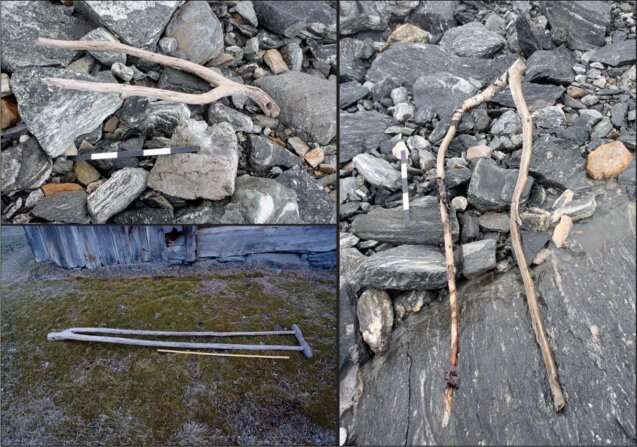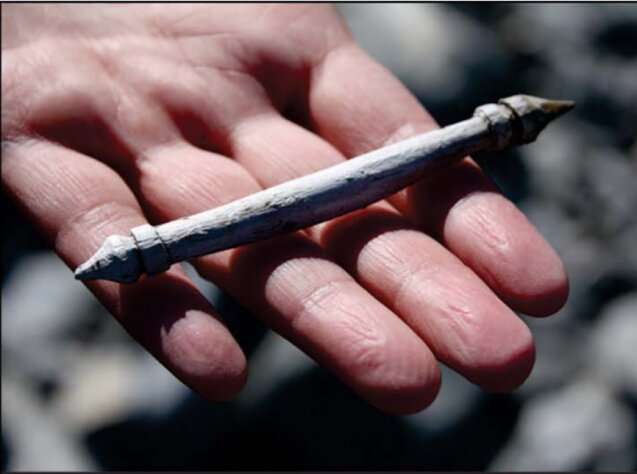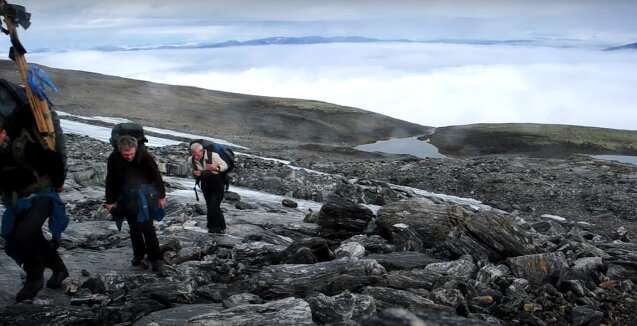Melting ice reveals an ancient, once-thriving trade route

High in the mountains of Norway, melting ice has led to the discovery of an ancient remote mountain pass, complete with trail markers and artifacts from the Roman Iron Age and the time of the Vikings. The remains reveal this route served a dual function historically: It was once a significant passageway for moving livestock between grazing sites as well as for inter-regional travel and trade. This particular receding ice patch is known as Lendbreen, and because of its tame geologic features, hundreds of artifacts have been pristinely preserved. Most are from the Viking Age, providing an odd inland perspective to the age-old tales of their audacious maritime journeying.
Glaciers and ice patches throughout the world's high mountain regions are receding, leaving behind precious artifacts, like Ötzi the ice man and his tool kit, that have been buried under ice for centuries. The rate of melt has been accelerating over the past few decades as a result of the warming climate. In the 1980s, glaciers lost less than a foot of ice per year, on average. That number increased every decade so that by 2018, glaciers around the world were losing mass at a pace of three feet per year. This rise in melt drastically propelled the field of glacier and ice patch archaeology—especially in Scandinavia, the Alps and North America—as archaeologists raced to collect artifacts uncovered by this process.
Earlier this year, Antiquity published an article about an ancient mountain pass uncovered on Lendbreen, a melting ice patch in the central mountain range of the Loomseggen Ridge in Norway. This retreating ice patch exposed lichen-free areas of bedrock where artifacts have been found simply lying on the bare ground. The dated artifacts indicate that the mountain pass was used from around AD 300-1500, but that its usage increased around AD 1000 during the Viking Age. This was a time of elevated travel, trade, and urbanization in Northern Europe.
The authors theorize that people began using the mountain pass in AD 300 (during the Roman Iron Age), when summer farming became more common in high elevations. "There might be many reasons why farming moved up the mountainside," said Mark Aldenderfer, a distinguished professor of anthropology at the University of California Merced. His archeological research is focused on the high altitude cultural, genetic, and biological adaptations required to live permanently above 2,500 meters. He noted that this study is a great example of ice patch archaeology. The artifacts shed light on the functioning of ancient agricultural societies.

When the climate warms, even slightly, new lands become available for exploitation as the ground thaws. "Land exhaustion in the lower valleys may have led farmers to seek new lands—but much depends on the nature of the cropping systems and the availability of fertilizers," he said. Even if lands weren't completely useful for growing food for humans, they could be used to grow hay and other feed (fodder) for their animals. This led to increased transhumance, the practice of moving livestock from a lower elevation grazing ground in the winter to a higher elevation grazing ground in the summer.
An important function of the high-elevation summer farms in Norwegian pastoralism was that, at the end of the summer season, fodder could be transported to downhill settlements. In this way, it would continue to nourish horses and cattle when snow covered the mountainsides. Fragments of leaf fodder and wooden implements, known as tongs, were among the artifacts found at Lendbreen that were associated with the transportation of fodder, and were radiocarbon dated to AD 264-533.
"These systems of land use are common in much of the world's mountainous places… people do this in Tibet and the Himalayas all the time," Aldenderfer added. "It would be interesting to see what kind of plants might be evidenced in the ice in order to see what was actually being planted." In the Himalayas, for instance, there are many varieties of barley that are cold-adapted and can come to fruition much faster than other types of barley in the world.
Eventually, long-distance travel and trade became more common in the region. In Lendbreen, the authors write that the fact that "the dates cluster in the Viking Age, particularly around AD 1000, is unlikely to be coincidental as it was a time of high mobility, emerging urbanism and increasing political centralisation in Scandinavia, and a period in which markets around the Irish, North and Baltic Seas were growing." This was a time when the societal demand for mountain products—such as pelts and reindeer antlers for making combs—rose and motivated both local and long-distance travel, consequently elevating both inter- and intra-regional communication and exchange.
The findings on Lendbreen are varied and contain numerous types of transportation-related items including the remains of sleds, walking sticks, horse-snowshoes, and horse bones. They also contain many everyday items, including a woven tunic and a mitten, textile rags, and a collection of shoes made from hide. Most notably, archaeologists found ruins of a stone shelter near the top of the ice patch, indicating that this was a significant travel route.
Horse-related artifacts are indicative of the actual path of the main route. Iron horseshoes are less likely to have been moved due to winds or other natural causes because of their weight. They also lie near the cairns that were erected to mark the path. Lighter objects off the main path may reflect alternative hunting routes up the mountain, or may simply reflect the way these objects were deposited by wind or glacial meltwater movement.
Horses are also an important area of study for archaeologists because they were the main source of transportation for many ancient peoples and have been domesticated many times throughout history. "Horse DNA is a big deal," said Aldenderfer. "In Europe, for the time frame of this particular study, it could be a situation in which somebody might say, 'Well, let's compare, maybe these horses did come from a breed from high-elevation or cold-adapted climate,'" so this could be something for future research to expand upon.
Historically, local people utilized glaciers for travel in the spring and early summer when the snowpack was deep enough to support packhorses and when the weather was not as brutal as during winter months. However, some stretches of the Lendbreen route contain very difficult terrain that would have been impossible to cross with packhorses in the absence of snow cover. The authors suggest that increased presence or absence of artifacts in certain centuries may reflect episodic patterns of alternative warming and freezing events. "Indeed, the glacier curves for the region show multiple expansions and contractions of high-elevation ice over the chronology of Lendbreen's use for hunting and as a mountain pass."

According to the authors, the late- and post-medieval decline in the mountain pass's activity likely reflects the onset of the Little Ice Age in 1300 and the appearance of the Bubonic Plague that reached Norway in 1348, which led to climatic deterioration, famine and depopulation across Europe.
The Lendbreen ice patch initially became a focal point for archaeological study in 2011, when a sheep wool tunic from the third or fourth century was found near the ice. The authors hypothesize that this garment may have been cast off by someone in the "irrational throes of hypothermia," as the New York Times put it. Since then nearly 800 artifacts, 150 bones and antlers, and over 100 cairns (man-made stacks of stones that served as trail markers) have been discovered by Oppland County's Glacier Archaeology Program.
Ice patches preserve ancient treasures better than glaciers—they are the best for this kind of archaeological work because they are usually less active and less dynamic than glaciers. "Ice simply buries material, creates conditions for long-term preservation, and generally keeps it intact. As the ice melts, artifacts might be moved, but not terribly far," Aldenderfer said. "But glaciers, man, they can be really rough. They pick stuff up, they move it up, they move it down, they crush it… the wave that glaciers bring is hard on artifacts."
Lendbreen is the only known mountain pass that traverses an ice patch, preserving artifacts lost by those past travelers in exceptionally pristine condition. Consequently, archaeologists were able to decipher that the mountain pass served a dual function historically: In addition to facilitating inter-regional travel trade, the route also allowed seasonal transhumance between lower-elevation settlements and higher-elevation summer farms on which livestock was grazed. Before its whereabouts were lost beneath the ice, this route was central to Norway's ancient mountain itineraries.
Journal information: Antiquity
Provided by Earth Institute at Columbia University
This story is republished courtesy of Earth Institute, Columbia University http://blogs.ei.columbia.edu.




















